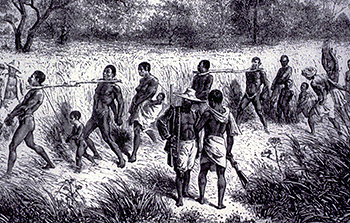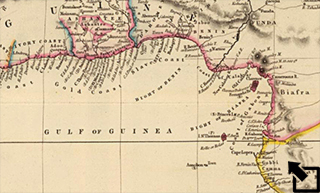
Slavery existed in Africa, as it did around the
world, for centuries before European exploration. Indeed, slavery still
exists today in many African countries almost one hundred fifty years
after the practice was officially outlawed by the chief practitioners of
the trade in Europe and the Americas. However, the period of enslavement
and forced migration from the early 1500s thru the late 1800s on which
this unit focuses was unprecedented in terms of the numbers and extent
of the practice. It is estimated that over twelve million individuals
were forced into slavery from African ports between 1501 and 1867.
Approximately two and a half million men, women, and children died in
the "middle passage" aboard ships bound for the Americas. By 1820 almost
eighty percent of the population of the new world had been forced to
emigrate from Africa.1 It is very easy to be overwhelmed by
the shear numbers involved; to lose sight of the magnitude of the human
nature of the transatlantic trade and the staggering impact on the human
communities involved.
Thus, we begin with one man's story.
Venture Smith was a native of Guinea in west Equatorial Africa. He was captured and sold into slavery as a boy in the 1730s. His account of his life's experiences as both a slave and a free man in New England is one of a few remaining first hand narratives of a life that reached across continents . Venture's story begins with recollections of his homeland:
I was born at Dukandarra, in Guinea, about the year 1729... I must just inform my reader what I remember concerning this place. A large river runs through this country in a westerly course. The land for a great way on each side is flat and level, hedged in by a considerable rise of the country at a great distance from it. It scarce ever rains there, yet the land is fertile; great dews fall in the night which refresh the soil. About the latter end of June or first of July, the river begins to rise, and gradually increases until it has inundated the country for a great distance, to a height of seven or eight feet. This brings on a slime which enriches the land surprisingly. When the river has subsided, the natives begin to sow and plant, and the vegetation is exceedingly rapid. Near this rich river my guardian's land lay. He possessed, I cannot tell exactly how much, yet this I am certain of respecting it, that he owned an immense tract. He possessed likewise a great many cattle and goats. During my stay with him I was kindly used, and with as much tenderness, for what I saw, as his only son, although I was an entire stranger to him, remote from friends and relations. The principal occupation of the inhabitants there, were the cultivation of the soil and the care of their flocks. They were a people pretty similar in every respect to that of mine, except in their persons, which were not so tall and stout. They appeared to be very kind and friendly. I will now return to my departure from that place.2
There are very few first hand accounts of the experience of being captured and enslaved from the point of view of a man like Venture Smith. His story continues in this excerpt from:
Through his account we get to know details of his personal history - his early life in Guinea, his capture and life as a slave, and, finally,his life beyond slavery as a man who purchased freedom for both his family and for himself.
Many accounts of the slave trade from the African perspective come to us second hand as part of a rich and enduring oral tradition. This song heard and the lyrics recorded in the late 18th century is one such example. Stories from the oral tradition are often transformed into a variety of forms as Huntokonu, a contemporary poem by Olaide Babatunde Mesewaku, a Nigerian writer, suggests.
1) What evidence is included in Venture Smith's Narrative that indicate the involvement of Europeans in the capture and transport of his people and others along the way to the coast?
2) The slave coast of Africa extended from approximately the Senegal River south of the Sahara Desert in northwest Africa around the Cape of Good Hope and up the coast opposite Madagascar. Open the map at right and measure the approximate length of this coastline.
3) The port of Anamoboo that Venture refers to in his narrative is marked on the map of Africa above. He indicates that he was forced to march some 400 miles in a westerly direction from his home to the port. Allowing for the fact that this was a boyhood memory and perhaps the distance was exaggerated, measure on the map and identify roughly where he might have lived.
4) The opening lines of the poem Huntokonu reads:
| Huntokonu |
The Ogu people are an ethnic group living today in southwest Nigeria, Benin, and Togo. What role in the slave trade does Olaide Babatunde Mesewaku, the author of the poem, suggest that the Ogu played in the trade?
5) For those who engaged in the transatlantic slave trade the lives and experiences of those like Venture Smith were irrelevant. Slaves were a perishable commodity - to be captured, sold to traders, chained in unimaginable conditions for the Atlantic crossing, jettisoned as they died (or were near death), and sold on arrival in the Americas into permanent servitude. The Voyages Database of African Names is a record of the human nature of this commodity.3 Each name in the database is derived from slaver's and ship's records. Each attaches to a human being. Ages and indications of relationships are evidence of family. They were boys and girls; men and women. Each was a native to African communities stretching thousands of miles from the near sub Saharan Atlantic coast of northwest Africa around the Cape of Good Hope to Indian Ocean islands off the southeast coast of the continent. There are over 90,000 records from over 35,000 slave voyages in the file.
Open the Voyages Database. Note that you can set Search criteria in the panel on the left and that any column can be Sorted by clicking on the heading at the top of the column. Notice also that by clicking on the arrow in the table's rightmost column you can get more detailed information about each individual.
Enter a search to determine how many of the Africans in the sample were Venture Smith's age or younger; that is, approximately 10 or younger at the time of capture? What percentage of the population in the database does this represent?
6) Approximately what percentage of the captured slaves were female (identified as Female, Girl, or Woman in the table)?
7) Create and answer your own question(s) related to the data in the table.
1David Eltis and avid Richardson, Atlas
of the Transatlantic Slave Trade, (New Haven: Yale
University Pres, 2010), xvii.
2Venture Smith. A Narrative of the Life &
Adventures of Venture, a Native of Africa, But resident above
sixty years in the United States of America. Related by Himself.
(New London, 1798). Downloaded Dec 3, 2016 from Project
Gutenburg.
3Emory University, "African
Names Database" a part of the Trans-Atlantic
Slave Trade site.
image from "Capture and Coffle of Enslaved Africans, Angola, 1786-87," Image Reference LCP-12. Downloaded Dec 3, 2016 from The Atlantic Slave Trade and Slave Life in the America.
Last modified in October, 2021 by Rick Thomas

